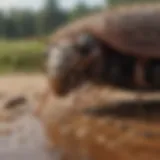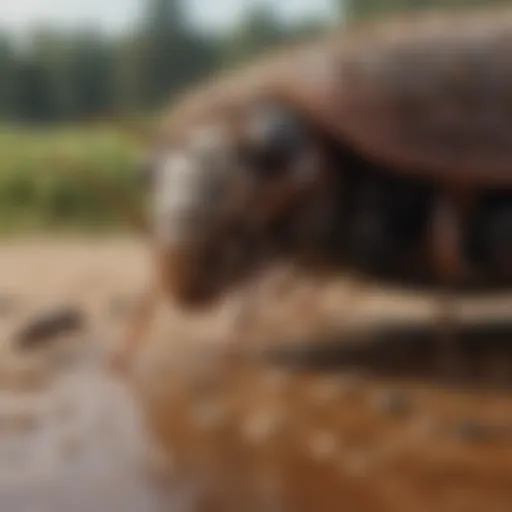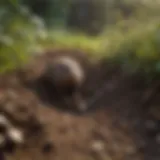Fumigation Safety Tips for Pet Owners
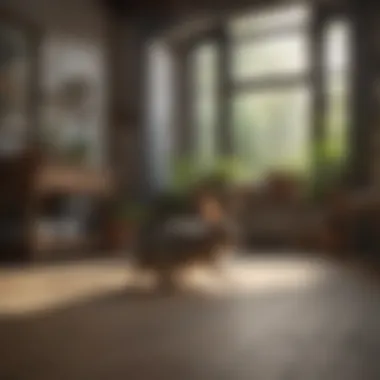

Intro
In the world of pest control, maintaining a safe and healthy environment for our pets is paramount. As homeowners, we all face the occasional battle with unwanted insects or critters, and the tactics employed can vary widely. From chemical sprays to physical traps, each method comes with its own considerations, especially regarding the furry members of our families. Understanding the intricacies of fumigation safety can be a game changer, ensuring that your home remains a sanctuary for your beloved pets.
We set the stage with preventive pest control strategies. These tactics are not just about eradicating pests; they also revolve around keeping our living spaces secure and pleasant for every being. Knowing where to start is crucial, and that begins with understanding your home’s vulnerabilities.
Preventive Pest Control Strategies
To effectively keep pests at bay, homeowners should adopt a multi-faceted approach. It's much like putting on an armor before heading into battle. Here’s how to start fortifying your home:
House Exterior Protection
Protecting the outside of your home lays the groundwork for a pest-free environment. Here are some useful tips for safeguarding the exterior:
- Sealing Cracks: Inspect your walls and foundation for visible gaps. Use caulk to seal cracks and crevices, ensuring no sneaky bugs make their way inside.
- Clearing Debris: Fallen leaves and clutter can attract pests. Regularly use a rake or broom to keep the yard tidy.
- Preventing Entry: Installing screens on windows and doors can provide an extra layer of defense against critters looking for a cozy spot.
Yard Maintenance
Maintaining your yard goes beyond aesthetics; it's crucial for pest control as well. Here are some essential routines to consider:
- Mowing the Lawn: Keeping grass at a reasonable height discourages pests that thrive in tall grass.
- Trimming Hedges: Bushes too close to the home can provide cover for pests; keep them trimmed and tidy.
- Planting Pest-Resistant Flora: Opt for plants known to repel pests, such as lavender or marigolds, to create a naturally pest-resistant garden.
Indoor Cleanliness
A clean home is a happy home, working wonders in preventing infestations:
- Regular Vacuuming: Especially in pet areas, vacuum frequently to remove any pet hair or crumbs that may attract pests.
- Storing Food Properly: Keep food in airtight containers to minimize access for ants and mice.
- Decluttering: The less clutter you have, the fewer hiding places for pests.
Garbage Disposal
Disposing of waste correctly is often overlooked but incredibly important:
- Sealing Garbage Bins: Always use bins with tight-fitting lids to keep pheromones from wafting into the air, which can attract a host of pests.
- Regularly Emptying Bins: Schedule a routine for disposing of garbage, ideally at least once a week.
Other Pest Prevention Strategies
Sometimes, unconventional wisdom works wonders:
- Using Diatomaceous Earth: Sprinkling this natural powder around potential entry points can deter pests without harming your pets.
- Companion Planting: Certain plants can repel pests when grown together, a method used in gardens for centuries.
- Encouraging Natural Predators: Birds, for example, can help control insect populations. Consider installing birdhouses to invite these helpful visitors.
"An ounce of prevention is worth a pound of cure."
By implementing these preventive strategies, homeowners can significantly minimize pest infestations before they require more drastic measures. The key is to maintain consistent upkeep, making sure your home is not only welcoming for your family but a fortress against pests.
As we move deeper into this article, we'll explore how to identify pest risk areas. This knowledge arms you with the ability to foresee potential challenges, allowing for proactive measures before the situation spirals out of control.
Understanding Fumigation
Fumigation is a critical procedure in pest control that often flies under the radar for many homeowners. Understanding what fumigation entails is essential for pet owners who may find themselves facing a pest issue. The stakes are high. Not only can infestations disrupt daily life, but they can also pose hazards to both humans and animals. Therefore, delving into the world of fumigation helps in making informed decisions that prioritize safety for everyone in the household, especially our four-legged friends.
Knowledge of fumigation methods gives homeowners insight into how these techniques can effectively eliminate pests while potentially safeguarding their pets. For instance, understanding the time-frame for treatment can help you organize your household routines and plan accordingly so that pets are not unintentionally exposed to harmful chemicals. This preparation is crucial in ensuring both the efficiency of pest eradication and the wellbeing of pets after the process has been completed.
Moreover, being informed about the chemicals used during fumigation, and their specific behaviors and risks associated with them, allows pet owners to take necessary precautions. There’s a difference between methods that utilize pet-safe substances and those that don’t, and this knowledge can help delineate choices that make a world of difference in ensuring pets remain unharmed. Awareness also fosters conversation should you need to consult pest control professionals, equipping you to ask informed questions.
In essence, understanding fumigation is not merely about grasping what occurs during the process; it’s about mastering how to coalesce effective pest control with the safety of our beloved pets. When practiced correctly, fumigation can turn what seems like a daunting challenge into a more manageable affair.
Definition of Fumigation
Fumigation is a pest control process that involves the use of chemical vapors to eliminate pests in both residential and commercial settings. This technique entails creating a gas that penetrates structures and eradicating pests, including insects, rodents, and microorganisms. Fumigation is notably effective against infestations that may not be visible or accessible, such as termites hiding within wooden structures.
The process usually involves sealing the space, allowing the gas to spread and act on pests over a period ranging from several hours to days, depending on the extent of the infestation and the chemicals used. Households often associate fumigation with a house being covered in a large tent, blocking out light and air. However, it can also apply to smaller structures, outdoor areas, and even soil to eliminate nematodes or other troublesome pests.
Common Uses of Fumigation
The application of fumigation is broad and varied. Here are some common uses that underline its importance:
- Structural Fumigation: This method targets residential homes, commercial buildings, and storage areas. It is particularly helpful for homes plagued by termites that may compromise the integrity of the structure.
- Food Safety: Fumigation is employed in agricultural sectors to protect stored grains and other food products from pests, ensuring safety and quality.
- Soil Treatment: Agriculture-oriented fumigation can sterilize soil, eradicating harmful pests and diseases that could affect crop growth.
- Transportation: Fumigation is vital in the shipping industry, where it helps to protect goods from pest-related damages.


In sum, fumigation serves as a multi-faceted tool to combat pest-related issues across various fields, highlighting its significance and practicality for safeguarding both properties and possessions.
Types of Fumigation Techniques
Fumigation is not just a one-size-fits-all approach; it varies significantly based on the situation, the pests being targeted, and the environment. Understanding the different techniques can help pet owners make informed decisions that prioritize the safety of their furry loved ones. Each method comes with its own set of benefits and considerations—some might be more effective than others in specific scenarios, while also having varying levels of risk to pets. Let's break this down into three primary fumigation methods: structural, soil, and tent fumigation.
Structural Fumigation
This method is commonly used to control pests in buildings, often targeting wood-destroying insects like termites. Structural fumigation involves sealing a building and introducing a gas that penetrates all areas, including spaces difficult to reach. A notable benefit here is that, once completed, the structure stays protected for a long period, reducing future pest infestations. However, it's paramount to ensure pets are not present during this process; the gases used can linger and be harmful to animals.
When considering structural fumigation, a few key points should be noted:
- Containment: The structure must be completely sealed for the fumigant to work effectively. This ensures that the gas does not escape into surrounding areas.
- Duration: The fumigation process may take several days. This includes preparation, actual fumigation time, and aftercare before it is safe to re-enter.
- Professional Oversight: It is essential to hire certified professionals who understand both the chemicals used and the potential effects on household pets.
Soil Fumigation
Soil fumigation is often employed in agricultural and landscaping contexts. This method targets soil-borne pests, fungi, and nematodes, making it particularly useful for farmers and garden enthusiasts. The process involves injecting a fumigant into the soil before planting so that it accumulates in the root zone. While effective in eliminating pests, it does pose hazards—specifically if indoor pets have access to treated soils or gardens post-fumigation.
Some important considerations include:
- Timeframe: After treatment, a waiting period is necessary before any humans or animals can safely interact with the soil; this can range from a few days to weeks.
- Visibility: Unlike structural fumigation, the effects might not be visible until the crops are actively growing, making ongoing communication with professionals crucial.
- Safety Precautions: Ensuring that household pets do not have access to areas that have been treated is essential.
Tent Fumigation
Tent fumigation, often referred to as "tarpaulin fumigation," is a widely recognized method used for large-scale pest issues, particularly in homes and silos. In this method, a large tent is placed over the structure, creating a sealed environment that allows for a controlled release of the gas. This technique is particularly effective for eradicating not only insects but also rodents.
Here are some key factors to keep in mind:
- Compatibility with Pets: Before the procedure starts, it’s crucial to relocate any pets, as they cannot be present during fumigation nor for several days afterward.
- Effectiveness: Because the tent creates a sealed environment, it allows the gas to reach all nooks and crannies where pests may hide.
- Regulations: Local regulations may dictate specific safety measures to ensure public health is monitored during and after this process.
In closing, understanding these fumigation methods enables pet owners to choose what best fits their situation while considering the safety of their pets. Remember, preparation and professional consultation are key to minimizing risks associated with fumigation.
Fumigation Agents and Their Risks
Understanding the various fumigation agents is crucial for pet owners who want to ensure the safety and well-being of their animals during pest control efforts. These agents, usually in the form of chemicals, serve a specific purpose in eradicating unwanted organisms, but they also pose potential risks. Identifying these risks beforehand helps in making informed decisions and in implementing safety precautions that protect both pets and household members.
Common Chemicals Used in Fumigation
Fumigation employs a range of chemicals, each with its own mechanism of action. Here are some common agents:
- Sulfuryl fluoride: This is a widely used fumigant for structural pest control. It's potent against termites and other wood-destroying insects. While effective, pets can be sensitive to its effects if exposed.
- Methyl bromide: Used more in agricultural settings, this chemical isn’t as common for residential fumigation but can still appear in certain circumstances. It's notorious for its toxicity and potential to impact health.
- Phosphine: Often utilized for grain storage, phosphine gas can be dangerous for pets if they inhale it during treatment. Its use requires careful monitoring.
- Chloropicrin: Primarily a warning agent, chloropicrin might be present to alert humans to dangerous situations. Nevertheless, it can still pose health risks to pets.
Each chemical has its own specific properties and safety protocols, so knowing what's being used in your home can help you plan accordingly.
Potential Toxicity to Pets
It's no secret that pets often act as family members, and their safety during fumigation should be a top priority. The potential toxicity of the above fumigants cannot be overlooked. When inhaled or absorbed, these chemicals can result in varying degrees of health complications:
- Respiratory Issues: Pets, particularly those with pre-existing conditions, may face severe respiratory distress when exposed to fumigants. Symptoms such as coughing, difficulty breathing, or lethargy should alert owners to the dangers lurking.
- Neurological Effects: Some chemicals could potentially cause a range of neurological symptoms. This can include coordination problems, seizures, or other serious reactions.
- Digestive Problems: Ingesting treated surfaces or even licking contaminated objects could lead to gastrointestinal upset, nausea, or vomiting in pets.
It's essential to note that the effects of fumigants can vary greatly depending on the size and species of the pet. What may be harmless for one animal could be detrimental for another.
Pet owners should maintain a proactive approach in monitoring their pets’ health and behavior in the days following a fumigation event. Regular checkups and open communication with veterinarians can further enhance readiness and response to any adverse reactions.
Assessing Fumigation Impact on Pets
When it comes to fumigation, many pet owners display a more than passing interest in understanding its effects on their furry companions. Pets, loved for their companionship, are often seen as part of the family. So, realizing how fumigation may impact their health and well-being is crucial for anyone with a cat, dog, or even a smaller pet like a rabbit.
The primary reason for assessing the impact of fumigation on pets is rooted in their vulnerability. Animals often react differently to chemicals than humans do. What's safe for you might not sit well with your pet. Just as you would check a new pesticide label for safety instructions regarding pets, it's just as vital to assess the consequences of fumigation before proceeding.
Understanding the effects can also help in making better decisions regarding pest control methods that suit your household. Moreover, there is a great benefit to knowing the short-term and long-term effects; doing so allows you to navigate fumigation cautiously, giving you peace of mind. With enough information at your disposal, you can better safeguard your household and ensure that your pets remain happy and healthy.
Short-Term Effects
In the immediate aftermath of fumigation, pets might exhibit various symptoms or reactions. These short-term effects can be alarming and, in some cases, warrant a visit to the veterinarian.
- Respiratory Issues: Pets may develop coughing, sneezing, or wheezing shortly after returning home. This could be due to inhaling residual chemicals or irritants that linger in the air.
- Behavior Changes: Look for sudden changes in behavior. If your normally playful dog seems unusually lethargic, or your cat is hiding more than ever, it might be something to monitor closely.
- Salivation or Vomiting: Some pets may experience nausea and, as a result, drool excessively or even vomit due to exposure to fumigants.
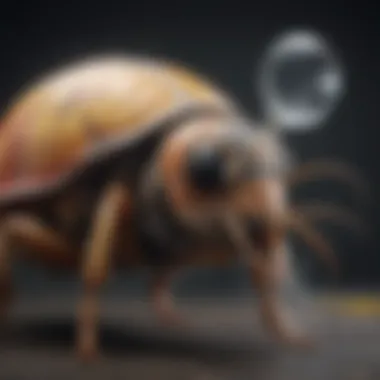

Here’s where vigilance plays a major role. Observing these signs will help you determine if it’s an immediate concern that needs addressing.
"Paying attention to your pets' reactions post-fumigation can mean the difference between a minor issue and a serious health risk."
Long-Term Effects
While short-term impact offers an urgent viewpoint, the long-term effects can be a lasting concern. These effects may not be apparent at first, appearing only weeks or even months down the line.
- Chronic Health Issues: Prolonged exposure or sensitivity to residual chemicals may lead to more severe health issues, such as respiratory conditions, skin irritations, or even cancers in some cases.
- Behavioral Changes: Some pets may experience ongoing anxiety or behavioral changes that surface long after the fumigation has taken place. If your pet becomes more fearful or aggressive, it could stem from trauma associated with the incident.
- Allergic Reactions: Pets can develop allergies to certain chemicals. It may not be evident initially but could lead to chronic skin problems or breathing difficulties over time.
Precautionary Measures for Pet Safety
When it comes to fumigation, particularly for households where pets roam around, taking precautionary measures is paramount. The safety of your furry companions hinges on understanding the processes involved in fumigation and the steps you can take to ensure they stay protected. In this section, we will delve into vital considerations that can help safeguard your pets throughout the fumigation process.
Choosing a Pet-Safe Fumigation Method
Selecting the right fumigation method is more than just a technical decision; it involves a careful assessment of how various methods can impact your pets. Not all fumigants are created equal—some are relatively safer for animals, while others can pose significant risks. Methods that utilize natural or less toxic agents, such as carbon dioxide or certain essential oils, can minimize exposure risks. It's crucial to consult with pest control professionals who are well-versed in pet-safe options.
However, beyond just the fumigation method, timing and execution also matter. A good idea is to inquire about the specific techniques being used and whether they are tailored for homes with pets.
Preparing Your Home for Fumigation
Preparation is key when it comes to fumigation. Prior to the treatment, homeowners should undertake specific steps to create a safe environment for their pets. Begin by removing pet items such as food bowls, bedding, and toys from the affected areas. Keeping a clutter-free environment helps mitigate potential exposure to harmful chemicals.
Moreover, sealing off areas to ensure that your pets cannot accidentally wander into treated zones is vital. This not only protects them but also enhances the efficacy of the fumigants used.
- Ensure all windows and doors are securely closed.
- Confirm with your fumigator about any additional guidelines.
- Store any medications or food in airtight containers to prevent contamination.
Relocating Pets During Fumigation
One of the most crucial steps in safeguarding your pets during fumigation involves relocation. It's strongly recommended that you find a temporary home for your pets while the fumigation process is underway. This can mean either boarding them at a pet facility or staying with friends or family until it is safe to return.
Making arrangements ahead of time can help alleviate any last-minute stress. While some fumigation processes may suggest short-term confinement, it is generally better to err on the side of caution, especially with household pets who are often sensitive to the chemicals involved.
For pets that are more skittish or difficult to manage, consider using calming techniques or medications prescribed by veterinary professionals to ease their anxiety during this transition.
“By taking these precautionary measures, you not only ensure your pet’s safety but also instill peace of mind throughout the fumigation process.”
By understanding the intricacies involved and preparing accordingly, pet owners can navigate fumigation with less worry, ultimately preserving the health and well-being of their beloved animal companions.
Post-Fumigation Protocols
Understanding the protocols to follow after a fumigation process is paramount for pet owners. While taking precautions during the fumigation is essential, the steps that follow are equally important to ensure the safety of your beloved pets. This part of the article will delve into the critical tasks that need to be performed post-fumigation, providing essential guidelines to help create a safe space for your furry companions. These practices not only safeguard the health of your pets but also bring peace of mind to pet owners, allowing them to return to a home that is both pest-free and safe.
Cleaning and Ventilating the Area
Once the fumigation process is complete, the first course of action involves thoroughly cleaning and ventilating the treated area. This practice is vital, as residual chemicals might linger in the air and surfaces, posing risks to pets and humans alike. To create a safe environment, consider the following steps:
- Open windows and doors: Allow fresh air to circulate throughout your home. The more airflow, the quicker the chemicals dissipate.
- Wipe down surfaces: Using a mild soap solution, clean countertops, flooring, and furniture where chemicals may settle.
- Wash textiles: Curtains, cushions, and other fabric items should also be cleaned. Give them a wash to remove any chemical residues.
- Vacuum the area: A thorough vacuuming helps pick up any particles that might have settled post-fumigation.
By adhering to these measures, you not only ensure a healthier space for your pets but also contribute to a more comfortable living environment for yourself and your family. A step well taken to lessen any lingering chemicals can save future headaches.
Reintroducing Pets Safely
The moment of truth comes when it's time to bring your pets back home after ensuring everything is clean and aired out. However, it’s critical to reintroduce pets back into your home in a safe manner. Here are some tailored guidelines to ease the transition:
- Wait at least 24-48 hours: Post-fumigation, allow extra time before bringing pets back. This buffer period ensures that any remaining chemicals, if present, have had a chance to dissipate adequately.
- Monitor their behavior: When reintroducing pets, do so gradually. Keep an eye on how they react to their environment. If they seem uneasy or show signs of distress, consider consulting a vet.
- Designate a safe space: Before they return, set up a cozy corner with their favorite toys, blankets, and perhaps some water and food. This can help comfort them as they readjust.
"Proper reintroduction not only secures your pet's health but also aids in easing their anxiety about being back home."
Utilizing these strategies can help ensure a smooth and safe transition back into your fumigation-treated home. Keeping a watchful eye during this period is crucial, as your pet’s safety and well-being are your top priority. Taking time and effort to follow these post-fumigation protocols can make all the difference in creating a safe haven for your pets.
Alternatives to Fumigation
When dealing with pest issues, fumigation may not be every pet owner's preferred route, particularly given the health risks involved for furry companions. Alternatives to fumigation can offer potential benefits and peace of mind for those who cherish their pets. Exploring various options enables a more holistic approach to pest management while ensuring that our beloved animals remain safe and sound.
Natural Pest Control Methods
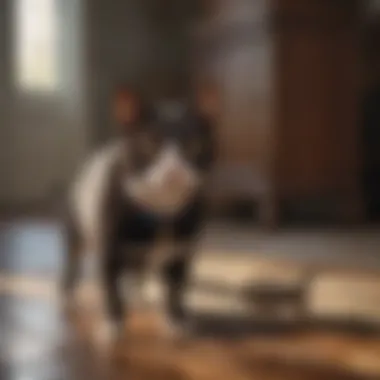

Natural pest control methods serve as effective alternatives to traditional fumigation approaches. They harness the power of nature, using less toxic substances, making them suitable for households with pets. Some of these methods include:
- Essential Oils: Many essential oils, such as peppermint, lavender, and eucalyptus, are known for their pest-repelling properties. They can be diluted and sprayed around your home to deter insects, while also being safe for pets if used properly.
- Diatomaceous Earth: This naturally occurring substance has a fine powdery texture. Sprinkling food-grade diatomaceous earth in infested areas can help control pests like fleas and bed bugs by damaging their exoskeletons. Just make sure pets don't ingest large amounts when applying it.
- Traps: Utilizing sticky traps or pheromone traps can tackle pest problems without chemicals. These traps are strategically placed in locations where pests frequent, capturing them without placing pets at risk.
- Beneficial Insects: Introducing beneficial insects like ladybugs or lacewings can help control pest populations naturally. These insects eat aphids and other common pests, creating a balance in your garden and minimizing chemical use.
Employing natural methods can minimize the impact on the environment as well as ensure your pets’ well-being remains integral in pest management strategies. However, one must remember that efficacy can vary; therefore, perseverance and knowledge are key.
Mechanical Control Strategies
If natural methods aren't enough, mechanical control strategies can be an excellent alternative to fumigation. These strategies focus on removing pests or deterring them without harmful chemicals, thus safeguarding the health of both humans and pets.
- Vacuuming Regularly: One simple yet effective method is maintaining a regular vacuuming schedule. This can help eliminate pests like fleas, ticks, and their eggs. Frequent vacuuming can also help clear away food debris that attracts pests.
- Physical Barriers: Installing screens on windows and doors can prevent pests from entering your home. Additionally, sealing cracks and crevices around your property can help minimize potential entry points.
- Traps and Repellents: Mechanical traps, such as rodent traps, can capture unwanted rodents without harmful chemicals. Similarly, ultrasonic pest repellents emit sounds that deter common insects and rodents without affecting your pets.
- Cleaning Up: Regular housekeeping will go a long way to prevent infestations. Keeping food stored properly, disposing of trash promptly, and cleaning up spills will cut down on food sources that attract various pests.
Using mechanical strategies not only resolves pest dilemmas but also creates a healthier living space for pets and humans alike.
Adopting these methods can be a refreshing change from fumigation. Not only do they prioritize the safety of pets, but they also promote a clean and safe environment against pests, aligning well with the well-being principles many pet owners uphold. Whether opting for natural remedies or mechanical interventions, a proactive mindset is essential for keeping those pesky invaders at bay.
Legal Regulations and Guidelines
Understanding the legal landscape surrounding fumigation is crucial for pet owners. These regulations serve as the framework not only for ensuring effective pest control but also for safeguarding the health and safety of animals that share these spaces. Compliance with local laws and guidelines is key for various reasons.
For starters, these regulations often mandate safety protocols that fumigators must follow, ensuring that the chemicals used do not pose undue risks to humans or pets. These laws can include stipulations about the types of chemicals that can be utilized based on their toxicity and the specific safety measures that should be in place during the fumigation process.
Additionally, by adhering to these regulations, you can also protect yourself legally. If any issues arise—be it adverse reactions from pets or failure to comply with statutory obligations—showing that you followed local guidelines can be invaluable. It not only highlights your commitment to safety but may also shield you from potential liabilities.
Local Regulations on Fumigation
Local fumigation regulations can vary significantly from one area to another. This patchwork of laws is often influenced by local pest problems, climate, and community preferences.
In many instances, municipalities outline specific chemicals that are prohibited for residential use due to their risk factors for pets. For example, overly toxic pesticides might be outlawed, and safer, albeit less effective, alternatives are recommended instead. Moreover, many areas require fumigation companies to be certified, ensuring that they are knowledgeable about local regulations and safety practices.
Here’s a quick recap of local regulations you should look into:
- Chemicals Used: Understand which pesticides are banned and the substitutes that are considered safe.
- Licensing: Check that your fumigation service provider has the necessary certifications.
- Notification: Some jurisdictions require homeowners to inform neighbors, especially if pets are nearby.
By familiarizing yourself with these nitty-gritty details, you’re setting yourself and your furry family members up for a safer pest control experience.
Guidelines for Pet Owners
For pet owners, following guidelines set forth by regulatory bodies can make a world of difference in keeping our four-legged friends safe during fumigation processes. Here are some key points to keep in mind:
- Pre-Fumigation Preparation: Before the actual fumigation, remove your pets from the premises. It’s often recommended to keep them safely away for at least 24 to 48 hours post-treatment, depending on the chemicals used.
- Ventilation: After the fumigation is completed, ensure that the area is well-ventilated. Open windows and doors for several hours to minimize chemical residue before bringing pets back.
- Regular Communication with Professionals: Keep in touch with the fumigation service providers. They can provide updated safety guidelines tailored to the specific chemicals they used in your area.
By implementing these guidelines, you are not only protecting your pets but also ensuring that the fumigation procedure is as effective as possible in controlling those pesky nuisances. Always remember that safety is a two-way street—taking the right steps minimizes risk, creating a safer environment for pets and humans alike.
Consulting Professionals
When it comes to fumigation, bringing in the right people is crucial for both effective pest control and ensuring pet safety. You may think you can handle it solo or follow DIY guides you find online, but fumigation is a delicate process that requires specialized knowledge. Without proper insight, you might inadvertently expose your pets to harmful chemicals or insufficiently deal with a pest infestation. Therefore, seeking expert advice is not merely a suggestion—it’s a necessity to maintain a healthy environment for your furry companions.
Fumigation professionals are trained to understand the various chemicals used and the best methods for their application. They can identify the safest fumigation methods suited to your home and its unique circumstances. Whether you have small pets, like hamsters and guinea pigs, or larger animals such as dogs and cats, professionals can advise on how to ensure their safety during the fumigation process.
Moreover, they can provide you with a detailed plan that outlines the steps to take before, during, and after fumigation. This includes how to relocate pets safely, air out your home, and when it's appropriate for pets to return. This layered approach minimizes risk and helps to ensure that your pets aren't exposed to harmful residues long after the work is done.
Consulting professionals can make a significant difference not only in pest management but also in ensuring the health and safety of your pets.
When to Seek Expert Advice
Not all situations call for immediate expert intervention, but recognizing when to seek professional help is key. If you’re facing a persistent pest problem that over-the-counter products can’t resolve, it’s time to dial in the pros. Ignoring a growing infestation can lead to more extensive damage to your home—and more danger to your pets.
Specifically, consider consulting experts in the following scenarios:
- Recurrent pest issues: If pests keep coming back despite your best efforts, it's a sign that there's a deeper issue that needs addressing.
- Risky chemical use: If you feel uncertain about the chemicals involved or have pets that may react negatively, a certified fumigator will have the answers.
- Unfamiliar methods: If the type of fumigation necessary isn't clear to you, experts can navigate this complexity.
Recognizing early signs and taking timely action can save you both headaches and heartaches in the long run.
Importance of Certified Fumigation Services
Choosing certified fumigation services goes beyond merely getting the job done; it's about ensuring peace of mind. Certified professionals bring a wealth of experience and knowledge, which enables them to conduct fumigation effectively while minimizing health risks for both humans and pets. They follow industry standards and guidelines—factors that often get overlooked by unlicensed services or independent contractors.
In particular, certified fumigators can:
- Customize Treatment Plans: They tailor plans according to the specifics of your home and pest problem, considering your pets' safety in the process.
- Educate Homeowners: These professionals often educate you about pet safety measures, so you're well-informed and can act accordingly.
- Verify Efficacy: After the fumigation process, certified experts can conduct thorough checks to ensure that the treatment was successful and pets can safely return to their environment.
Using certified services significantly lowers the chances of mishaps that could endanger your pets. They know how to handle chemicals and materials to ensure that safety ranks at the top of their priorities. Trusting experts can ease any anxieties about fumigation and its aftermath, paving the way for a pest-free, safe home for both you and your pets.
